What does a reference manager do?

Juggling numerous sources and references can be overwhelming. However, with a reference manager, you can organize and cite research materials much more efficiently. But what does a reference manager do?
⇨ What is a reference manager?
A typical reference manager allows you to undertake the following types of tasks:
| Reference manager features | Description |
|---|---|
Centralized reference collection | A reference manager serves as a centralized hub for all your research materials. It allows you to import references from diverse sources, including academic databases, library catalogs, websites, and PDF files. By aggregating your references in one place, a reference manager simplifies the process of accessing and retrieving relevant sources. |
Efficient organization | With a reference manager, organizing your references becomes a breeze. You can create folders or collections to categorize your sources based on topics, projects, or any other organizational scheme that suits your needs. This systematic arrangement ensures that you can quickly locate specific references when needed, saving valuable time during the research process. |
Seamless citation management | One of the most powerful features of reference managers is their ability to generate citations and bibliographies effortlessly. Whether you're writing an academic paper, thesis, or dissertation, reference managers can automatically format your in-text citations and generate a bibliography according to various citation styles, such as APA, MLA, Chicago, and more. This ensures consistency and accuracy in your citations, eliminating the risk of manual errors. |
Annotation and note-taking | Reference managers often provide annotation and note-taking functionalities within PDF documents. You can highlight important passages, add comments, or create summaries directly within the tool. This feature enables you to extract key information and insights from your sources while keeping everything organized and easily accessible. |
Collaboration and sharing | Reference managers foster collaboration among researchers. Many platforms offer features that allow you to share references or entire libraries with colleagues or team members. This enables seamless collaboration on projects, making it easier to work together, exchange ideas, and stay on the same page throughout the research process. |
Enhanced discoverability | Reference managers often provide tools for discovering new research papers and articles. They may suggest relevant sources based on your existing library, recommend related articles, or provide search capabilities within their integrated databases. These features help you stay up-to-date with the latest research in your field and expand your knowledge base. |
For instance, the Paperpile reference manager offers robust search capabilities, allowing you to search within your entire library or specific folders. You can:
- Organize your references into collections
- Add tags
- Create custom folders for better organization and retrieval
Paperpile also offers mobile apps for iOS and Android devices, allowing you to access and manage your references on the go. You can sync your library across different devices, ensuring your research materials are always at your fingertips.
What users say:
“Paperpile is feature-rich, but still structured and intuitive.”
-Student, University of Applied Sciences Bremen
“Paperpile makes it easy to save and organize my to-read list and prevents tab overwhelm.”
-Research Associate, University of Alberta